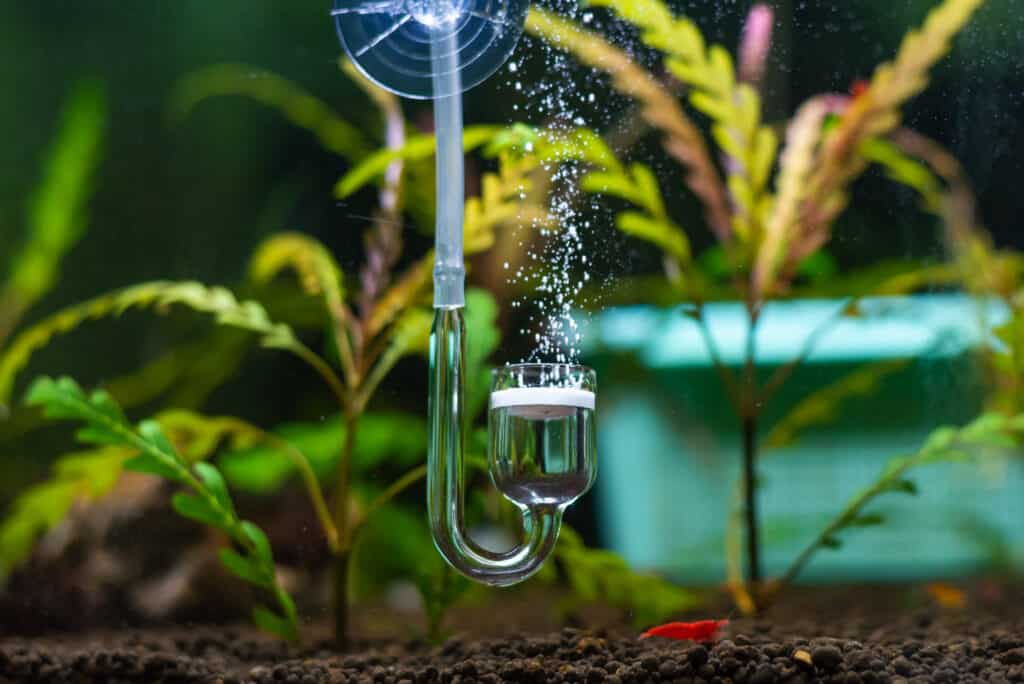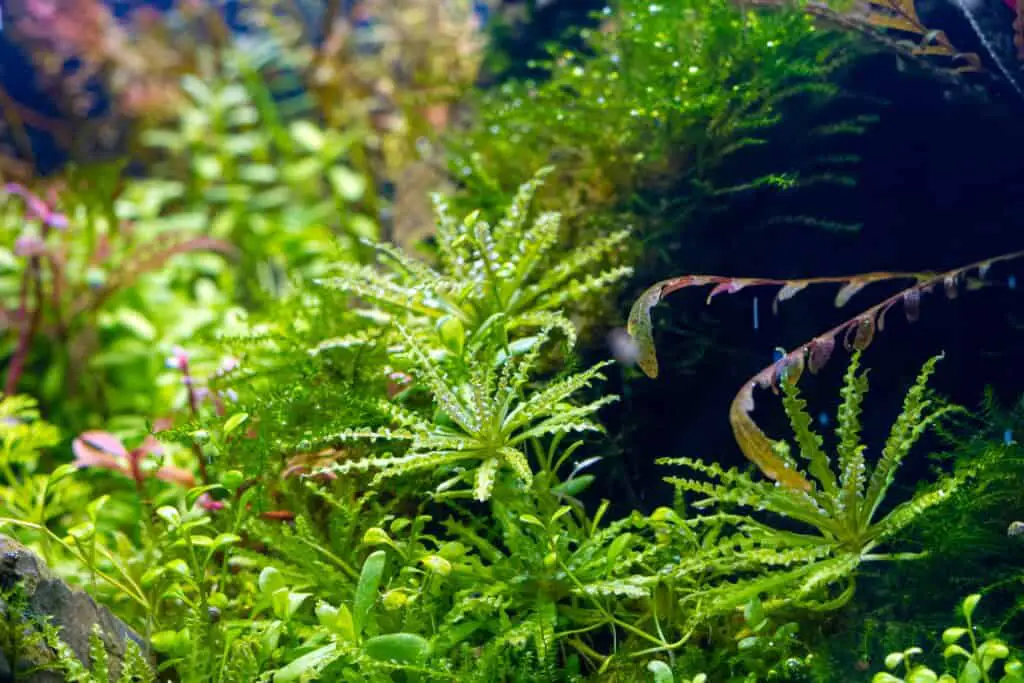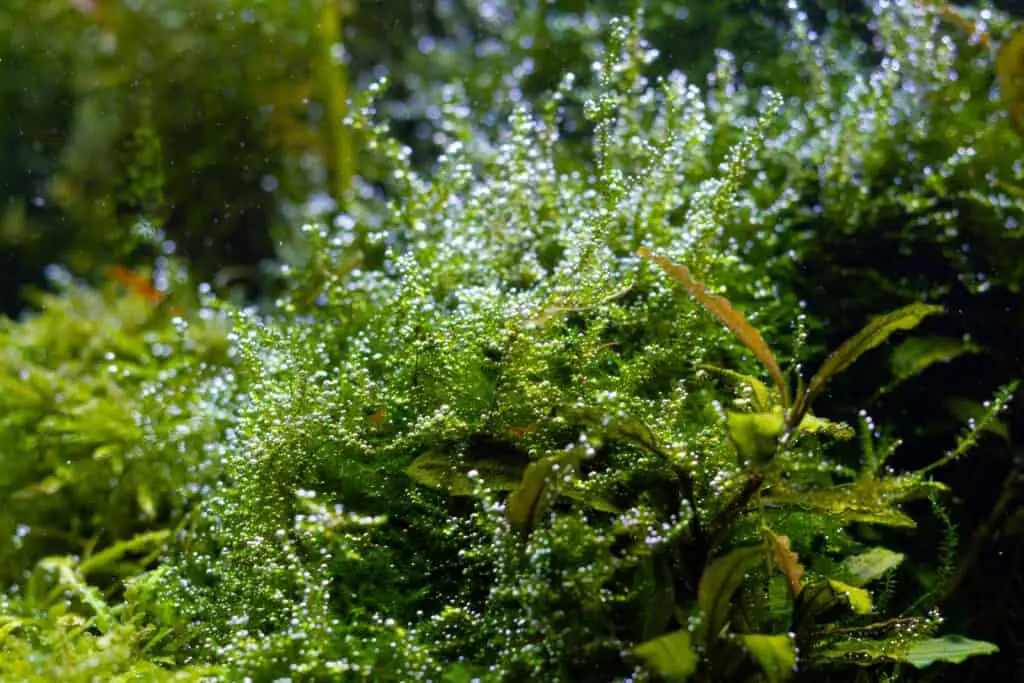
It is commonly understood that maintaining a health tank ecosystem involves a special balance. Particularly in planted tanks, a major resource to its overall health is Carbon Dioxide (CO2).
CO2 distribution should begin between 30 and 60 minutes before the tank lights are set to turn on. CO2 should continue to be released for the length of time that the tank lights are on, generally 8 to 12 hours. It should then be stopped roughly 30 to 60 minutes before the tank lights are set to turn off.
Let’s dive into how these recommendations are determined, and what should be monitored to determine if any type of adjustments are needed.

How Plants Use CO2
Like plants that we see every day, the plants in an aquarium rely on photosynthesis to survive.
This requires three things, CO2, light, and water.
CO2 plays a vital role in this process, as it is one of the main sources of carbon that plants use to produce energy and in turn, grow.
When light is present, plants begin to absorb CO2 from the surrounding areas, converting it into oxygen and sugars.
This is beneficial for the tank inhabitants, as fish and other creatures benefit from the oxygen being produced.
An important thing to remember from this process is that since light is required, when the tank light is off, photosynthesis is not occurring, and therefore any additional CO2 will not be absorbed.
Timing CO2 with Lighting
With light being needed for the CO2 to be beneficial to your live aquarium plants, you might be wondering why CO2 should begin being distributed slightly before the light is on, and then off slightly before the light is turned off.
This is because the concentration of CO2 needs to be increased in the tank so that plants can use it for their benefit.
This takes time, so with the flow of CO2 beginning before the lights begin on, it means that once the lights turn on the environment is fully optimal for the plants to immediately begin the photosynthesis process.
Much the same for the reasons to begin pumping CO2 slightly before the lights, it holds for shutting it down.
Since the plants need light, if you turn the CO2 off before the lights go off, it reduces the waste as the plants will use what remaining concentration of CO2 for the 30-60 minutes between the flow being turned off, and the lights turning off.
Determining the Duration of CO2 Injection
CO2 injection duration can vary based on several factors: the type and amount of plants, tank size, and the amount of light.
In general, larger tanks and tanks with more plants will require a longer duration of injection than smaller, less densely planted tanks.
A balance though to the amount of CO2 being injected should be sought after because too much CO2 can be harmful to the tank inhabitants as it drops the oxygen levels.
Be sure to use a CO2 drop checker to determine when the optimal amount is reached.
This simple device is placed in the tank, with a solution placed in the bulb.
This solution changes color based on the concentration of CO2 in the water.
A good starting point for the duration of injection is to match it to the amount of time there is light on the aquarium since this is the amount of time the CO2 will be beneficial to the plants.

Monitoring and Adjustments
Observing your tank is an important aspect of figuring out how long you should be running your CO2.
Fish Gasping
Be sure to take a look at your fish.
One of the dangers of running CO2 is having too high of a concentration of CO2 which can lead to your fish suffocating.
If you notice your fish gasping or struggling to breathe make sure to stop your CO2, and consider reducing the amount being put in, and also the duration that you are running it.
Drop Checker
A drop checker is an important tool to have, this simple device has a solution that changes colors based on the concentration of CO2.
There are typically three colors, they may vary by manufacturer, but the range is normally low CO2 concentration, an in-range concentration, and a too-high concentration.
pH
Be sure to also periodically check your tank’s pH.
Adding CO2 can cause the water to become more acidic, this can affect your fish and other species, especially ones that perfect less acidic waters.
Pearling
Pearling, or bubbles coming from your plants are another observation that means your plants are producing more oxygen than usual.
This shows photosynthesis is occurring at a faster rate and is a great sign that your plants are growing healthy and that your current CO2 timings are in a good balance.
Final Thoughts
Determining when and the length you should be running your CO2 is all about balance.
It is not a complete flip of a switch and letting it go.
The starting points of starting and stopping the distribution 30-60 mins before the lights turn on, and before they turn off, and running it the length of time the lights will get you started, but overall it’s a dynamic process that will require observation and adjustments.
Understanding how plants use the CO2, and aligning the setup based on lighting will give you the most optimal setup that can lead to a lush aquatic landscape while keeping your inhabitants healthy and happy.
